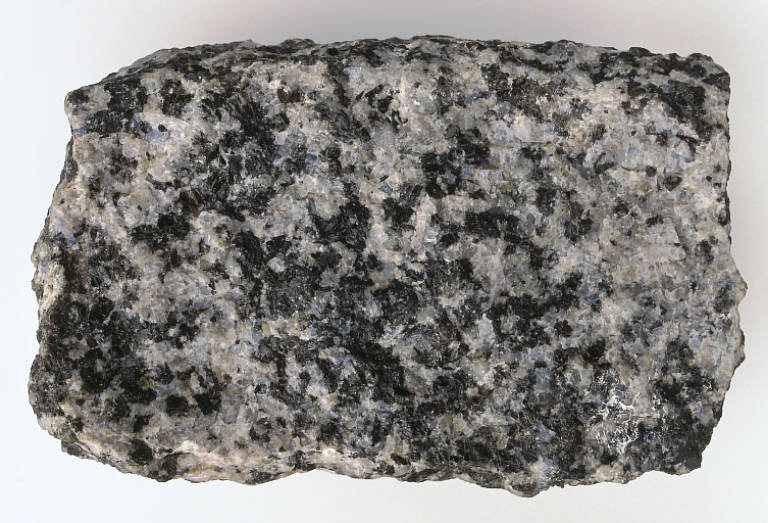Granite
Most granite is in the SiO2
(silica) form. Granite is a common widely occurring type of intrusive, felsic, igneous rock which is granular and
crystalline in texture. This rock consists mainly of quartz, mica, and feldspar. Occasionally some
individual crystals (phenocrysts)
are larger than the groundmass, in which case the
texture is known as porphyritic. A granitic rock
with a porphyritic texture is sometimes known as a porphyry. Granites can be pink to gray in color, depending on
their chemistry and mineralogy. By definition, granite is an
igneous rock with at least 20% quartz by volume. Granite differs from granodiorite in that at
least 35% of the feldspar in
granite is alkali feldspar as opposed to plagioclase; it is the alkali
feldspar that gives many granites a distinctive pink color. Outcrops of granite tend
to form tors and rounded massifs. Granites sometimes occur in circular depressions surrounded by a range of hills, formed by
the metamorphic aureole or hornfels. Granite is usually
found in the continental plates of the Earth's crust.
Gneiss
Gneiss is
a common and widely distributed type of rock formed by high-grade regional metamorphic processes from pre-existing formations that were
originally either igneous or sedimentary rocks.
Coquina (Shellstones)
Coquina is
a sedimentary rock that is composed either wholly or almost
entirely of the transported, abraded, and mechanically sorted fragments of the shells of
either molluscs, trilobites, brachiopods, or other invertebrates. For a sediment to be considered to be a coquina, the
average size of the particles composing it should be 2 mm or greater in
size. Coquina can vary in hardness from poorly to moderately-cemented. The term
"coquina" is derived from the Spanish word for cockleshells or
shellfish. Incompletely consolidated and poorly cemented coquinas are
considered grainstones in the Dunham
classification system for
carbonate sedimentary rocks. Well-cemented coquinas are classified as
biosparites according to the Folk classification
of sedimentary rocks.
Quartz
Quartz is
an abundant mineral in the Earth's continental crust. It is made up of a continuous framework of SiO4 silicon–oxygentetrahedra, with each oxygen being shared between two
tetrahedra, giving an overall formula SiO2. There are many different varieties of quartz,
several of which are semi-precious gemstones.
Throughout the world, varieties of quartz have been, since antiquity, the most
commonly used minerals in the making of jewelry and hardstone carvings.
Feldspar
Feldspars (KAlSi3O8 – NaAlSi3O8 – CaAl2Si2O8)
are a group of rock-forming tectosilicate minerals which
make up as much as 60% of the Earth's crust.
Feldspars crystallize from magma in both intrusive and extrusive igneous rocks,
as veins, and are also present in many types ofmetamorphic
rock. Rock formed almost entirely of calcic plagioclase feldspar
(see below) is known as anorthosite. Feldspars are also found in many
types of sedimentary rock.
Hornblende
Hornblende is a
complex inosilicate series of minerals (ferrohornblende
– magnesiohornblende). It is not a recognized mineral in its own right,
but the name is used as a general or field term, to refer to a dark amphibole. Hornblende
is an isomorphous mixture of three molecules;
a calcium-iron-magnesium silicate,
an aluminium-iron-magnesium
silicate, and an iron-magnesium silicate. The general formula can be given
as (Ca,Na)2–3(Mg,Fe,Al)5(Al,Si)8O22(OH,F)2.
Mica
The mica group of sheet silicate (phyllosilicate) minerals includes
several closely related materials having close to perfect basal cleavage. All are monoclinic, with a tendency towards pseudohexagonal crystals, and
are similar in chemical composition. The nearly perfect cleavage, which is the
most prominent characteristic of mica, is explained by the hexagonal sheet-like
arrangement of its atoms.








No comments:
Post a Comment